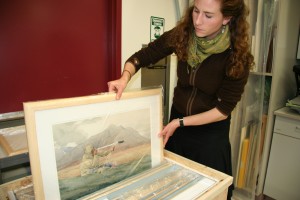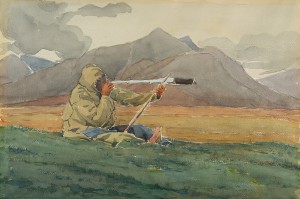Wyman watercolors return to Anaktuvuk Pass
December 1, 2011

907-474-6941
12/1/11
Reproductions of paintings created during a 1950s retreat to the Brooks Range have been donated to the community of Anaktuvuk Pass. The originals are housed at the University of Alaska Museum of the North.
The artist, Jeffries Wyman, helped discover a new branch of biochemistry and embarked on a series of global pilgrimages, including a painting retreat to the University of Alaska Fairbanks weather station at Anaktuvuk Pass. He produced over 100 drawings and watercolors there, as his daughter, Anne Wyman, described in the book “Kipling’s Cat: Memoir of My Father.”
“He ate caribou or sheep the men sighted with ancient telescopes steadied on fork sticks. All of this figured in a series of beautiful cobalt and sepia watercolors of the landscape and – for almost the only time in his painting life – of the people he lived with.”
Anne Wyman and her brother Jeffries Jr. donated 17 watercolors and drawings to the University of Alaska Museum of the North and provided the funds for high quality reproductions to be framed and shipped to Anaktuvuk Pass for display at the Simon Paneak Memorial Museum.
Mareca Guthrie, the UA Museum of the North’s fine arts curator, helped coordinate the donation. She praised the Wyman family for their work to preserve the paintings.
“Museums have two conflicting goals, preserving objects so that they can be experienced by future generations, and ensuring that they get to be seen and enjoyed now,” she said. “Because watercolors are so sensitive, we decided it would be best to keep the originals in the climate controlled environment of our museum, but it was also important for Anaktuvuk Pass to have something to display.”

“I love the paintings,” Wyman said. “But I am getting old now and trying to think of what to do with the rest of his pieces. We are particularly glad that the Alaska paintings and the journals have found a home.
Guthrie said photographs are the typical visual form we use to explore the mid-twentieth century, but drawings and paintings offer an even more personal lens. “Some people think that the act of drawing from observation is a sort of meditation on the subject. The artist is drawing, not just with his hands, but with his eyes, head and heart. When you look at the watercolors you can see the respect and tenderness the artist had for his hosts—and it is that personal connection that I like the most."
Vera Woods, the director of the Simon Paneak Memorial Museum in Anaktuvuk Pass, said the paintings have been well received. “They are hanging beautifully in the Elder’s Room, and the people love them.”
ADDITIONAL CONTACTS: Mareca Guthrie, UA Museum of the North fine arts curator, at 907-474-5102 or via email at mrguthrie@alaska.edu.
ON THE WEB: museum.uaf.edu
NOTE TO EDITORS: Images are available for download from www.uafnews.com.
TB/12-1-11/118-12


